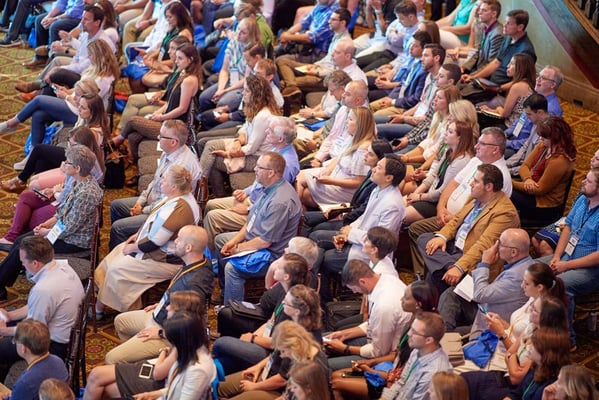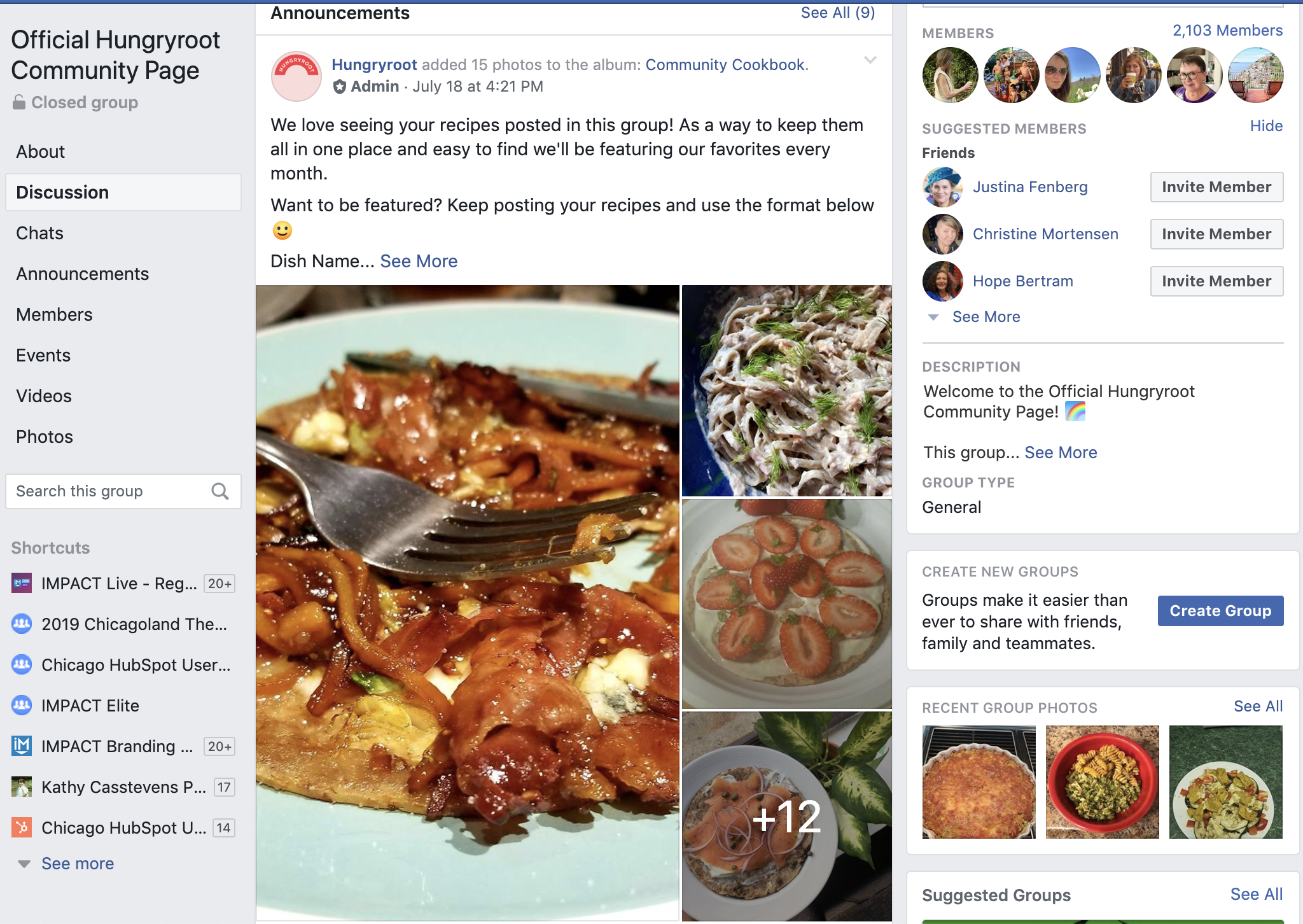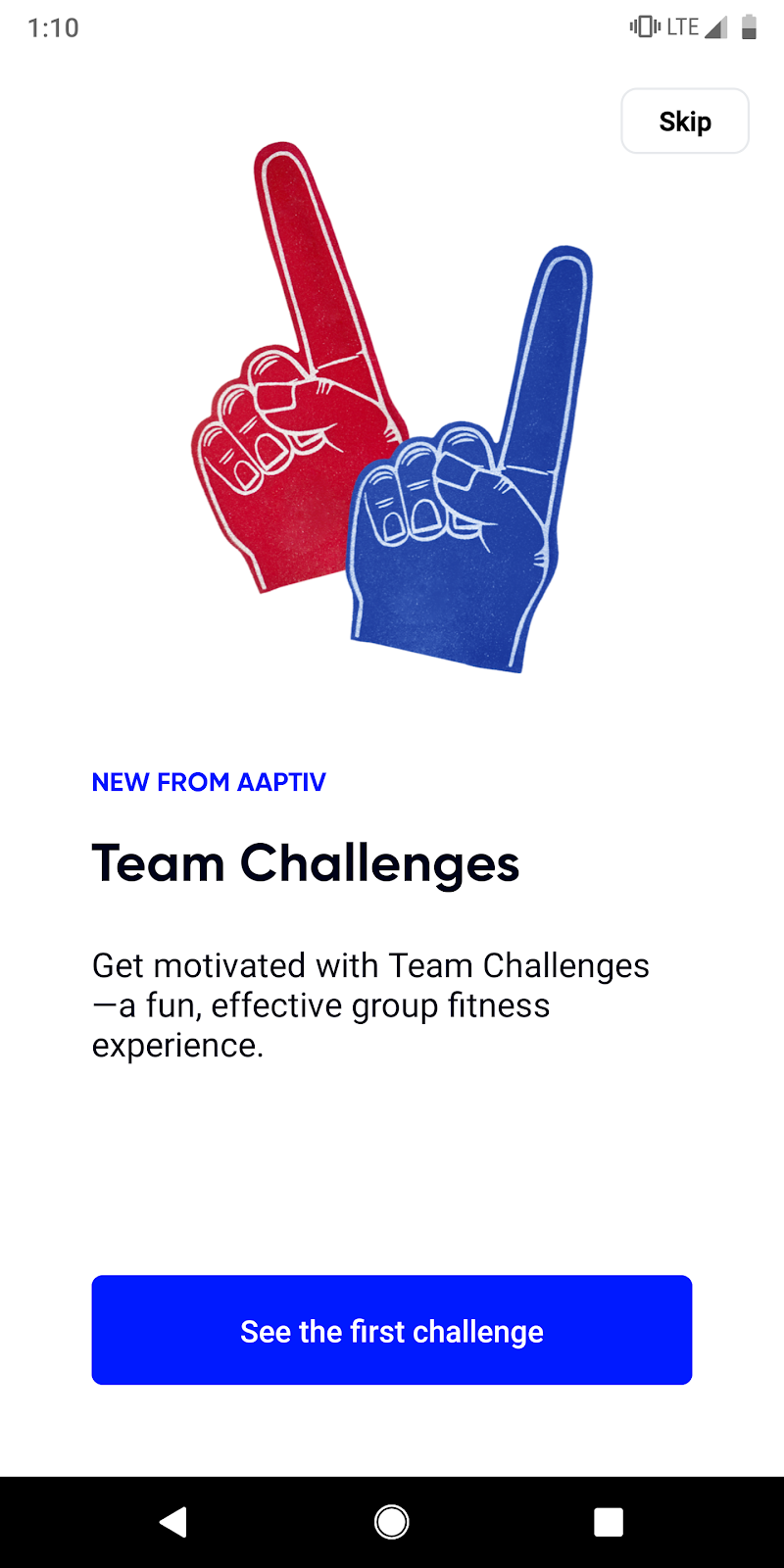Subscribe now and get the latest podcast releases delivered straight to your inbox.
Audience vs. Community: What's the Difference for Your Brand?

Aug 14, 2019

When I joined the team at IMPACT, there was a lot of discussion before we settled on my official job title, “Director of Audience Engagement and Community.”
The words “audience” and “community” are similar, but they’re also different enough that it was important to me we included both.
A few months later, at IMPACT Live 2018, I stepped onto the stage to teach our attendees about online communities.
The first thing I pointed out was that I was standing on a stage facing a group of people, talking at them, and they were (hopefully) listening. This was an audience.

Me on stage at IMPACT Live 2018 talking about audience vs. community.
Next, I asked how many people in the audience were wearing their IMPACT Elite membership pins.
Hands proudly shot up around the room. That was our community.
Author Chris Brogan once said, “the difference between an audience and a community is which way the chairs are facing.”
Sure, putting the chairs in a circle makes things feel more like a community, but there’s even more to it than that, especially when you’re creating an online community.
An online community can generate new leads, improve customer retention, add value for your existing customers, and give you deeper insight into who you’re talking to. Your audience is merely a part of this.
So what exactly is the difference between an audience and a community — and why does it matter to your business?
The differences between audience and community
Both your audience and your community comprise a group of people who care about what you're doing or, at the very least, the problem your product or service solves.
Both might include your customers, prospects, employees, and other key stakeholders.
The key differences, however, start to appear when you look at how you communicate with each group and how you track and measure your interactions with them.
I like to think of it like this:
- Your audience is who you talk to.
- Your community is who talks to you.
Audiences can be purchased; communities must be earned.
An audience is a group of people who consume your content, independent of one another. In other words, they may or may not have a relationship with each other.
When you refer to your audience you may speak in terms of audience size, list size, follower volume, or subscriber count. You’re usually just looking at size or quantity.
Building a large, high-quality, engaged audience is certainly challenging. However, you can simply purchase one. Whether you’re buying a list (don’t do that!) or paying to sponsor an event, you’re paying to get in front of a new audience.
A community goes beyond simply the group or number of people experiencing your brand on their own. It brings them together in one place for a shared experience.
It takes the one-way nature of talking to your audience and turns it into a dynamic, multi-way conversation among people.
Your community members are aware of one another and engage in conversation. They become a resource for each other and, as your community grows and matures, the members feel part of something bigger than themselves.
A community is a living, breathing entity.
“It's a collection of people connecting through a shared interest on a common platform, engaging in a back-and-forth dialogue. When the people in your audience come to a specific place to engage in a discussion about a topic of collective interest — and do this consistently — that’s a community.” - The Definitive Guide to Online Community Management by Stephanie Baiocchi
Your audience may care about what you have to say, but your community connects the people who care and brings them together to form a shared identity.
Unlike an audience, you cannot buy a community.
A community must be nurtured carefully over time. It is made up of individuals who share the common interest your community provides and get to know each other through their experience.
Audiences must be engaged by you; Communities engage with you on their own.
An audience is essentially just a group of people who might listen to you.
Maybe they’re subscribed to your emails or are sitting and listening to you speak at an event.
Their interest is fleeting. It may not last over time and they’re likely part of many similar audience groups.
Engaging your audience online requires consistent outreach and advertising to stay top of mind. Plus, there is natural attrition in audience data as jobs or names change and email addresses become obsolete along the way.
While communities require committed engagement too, once a community is developed and the members feel comfortable, they will engage among themselves without your guidance.
When your space becomes a place people go intentionally, instead of something they passively allow to show up in their inbox, you’ve built a true community.
Ideally, your community becomes the go-to resource for that topic of interest and is the only place your members go for that information or engagement.
Audiences are impersonal; communities recognize the individual.
Audiences are focused much more on a general reach of your audience. You constantly want to see the size of it getting bigger, with very little attention to the specific individuals that make it up.
A community is quite the opposite. Your community is about unifying people around your brand but, at the same time, enabling personal and individual interaction.
Someone may subscribe to your newsletter and become a part of your audience, but when they join your community, they get to engage on a one-to-one level with other members and with your brand.
They get to start a conversation and have the opportunity to stand out and be recognized as an individual, rather than just a number in your audience.
Audiences can be ruthless; Communities are forgiving and supportive.
The loyalty that comes with belonging to something bigger than yourself is a paramount benefit of a community.
When looking for a product or service to solve their need, people who are members of an audience will simply look for things like the cost compared to competitors, they’re purely about facts and numbers.
Community members look beyond these things.
Those who are members of a community will consider that when evaluating the community’s solution to their needs; their deeper value.
Community members incorporate the added value of the community into their evaluation of a business.
For example, I personally have continued to pay full price for my Hungryroot meal box subscription even though it’s more expensive than some competitors or even just buying the food myself.
It’s not just because of the ease of use though. It’s because of the community I’m part of by being a Hungryroot customer. We talk about health and fitness, share recipes, and more.

Plus, when people recognize your greater value, they can feed your customer retention and even referrals.
In addition to sticking with you over time, community members are much more forgiving when you make one of those dreaded but inevitable mistakes.
Whether it’s a little typo in an email or a massive, public faux pas, your audience may never let you live it down.
However, your community is not only more likely to forgive you; they may even jump to your defense.
Let’s take a look at how you can build a loyal, thriving community for your business.
Growing an audience vs. building a community
In addition to being different by definition, the way you build and grow an audience is different than how you build and grow a community.
Some key tools and techniques for growing an audience include conversion optimization to capture subscribers, social listening, consistency in messaging, virality and shareability of content, and SEO.
While some of these apply to communities as well, community management requires even more work and specific techniques.
For an online community to be successful, you need to incorporate elements such as a specific name and branding, clearly posted and enforced rules, commonly used member language, and traditions and rituals.
It’s more about creating a culture and environment rather than just hitting big numbers.
Furthermore, since a community is a pooling of shared knowledge and resources, the contributions of the members should be recognized and celebrated. This makes them feel appreciated and want to return.
A great community thrives beyond the leader, the platform, or even the product it is related to.
Here are some examples of businesses that have built thriving communities.
Examples of businesses with thriving communities
B2C non-subscription: Starbucks
Audience: coffee drinkers, nomad workers
Customers: people who make a purchase at Starbucks
Community: Leaf Rakers Society
What started as a fan group for lovers of Starbucks’ PSL (pumpkin spice latte) has transformed into a community of people who are so passionate about Starbucks, coffee, fall, and winter, that they share anything and everything they think other Leaf Rakers may love, without hesitation.
Starbucks has almost completely removed itself from the content and discussions in the community and yet it still thrives. In fact, I’m a loyal Leaf Raker myself!
As a brand, it may not seem like a community like this does much for a brand, but it does. While fans like myself have a fun play to connect with others on a common interest, the brand has candid insight into what we’re thinking and feeling. It’s all great information to have for future campaigns or product development.
B2C subscription: Aaptiv
Audience: People who have subscribed via email or follow on Aaptiv on social media
Customers: paying members using the Aaptiv app
Community: #TeamAaptiv exists both in the app and in Aaptiv’s Facebook group.
Members of the community talk about the workouts and trainers, but also share personal wins, challenges, and lessons learned.
In the app, members can cheer each other on through their fitness journies and even complete challenges as a team with other members of the community. (Surprise, I’m also a loyal Aaplete — that’s an Aaptiv athlete).

Similar to Starbuck’s Leaf Rakers Society, Team Aaptiv’s helps the company keep tabs on what their fans are talking about. Meanwhile, fans have a place to connect and get and stay motivated, which can often be quite difficult in fitness.
B2B: HubSpot
Audience: blog subscribers, those who follow HubSpot on social
Customers: freemium and paying users of HubSpot’s tools
Community: Oh the many communities of the HubSpot world. If you’re familiar with HubSpot you know it’s kind of like Crossfit — you’ll know if someone is a HubSpot user because they’ll tell you all about it. They have HubSpot User Groups, an online forum, several official and unofficial Facebook groups; the list goes on.
Anyone who has ever said they “bleed orange,” was a member of Hubstars, is a partner agency like IMPACT, or has attended the INBOUND event in Boston, is probably part of the HubSpot community.
As a company who has really championed a new approach to marketing with inbound, HubSpot’s community is a valuable asset in helping that “gospel” spread, while members in it have the opportunity to meet potential partners, employees, or employers.
It’s another win-win.
Overall, truly great communities offer value to both the brand behind them and the customers in them. From “delight” and a sense of belonging for members to candid insights for the brand, well-run communities need to reward both parties.
So, do you have an audience or a community?
Now it’s time to take a step back and look at your brand. Do you have a community, or do you just have an audience?
Audiences are essential, do not get me wrong, but a community’s value will last far longer.
So, ask yourself is this: If you stepped out of your community — if you removed your branding and your content -- would your community continue on without you?
If you answer is “yes” congrats! You’ve created quite a community. Now it’s time to harness the power of that community by continuing to engage your members and making the group a valuable resource for them.
If your answer is “no” you probably have some work to do. Fortunately, I created this ultimate guide to managing an online community that can help you understand how to turn your audience into a community.
While you’re at it, you’re welcome to join our community, IMPACT Elite, to learn more about it!
Free Assessment: